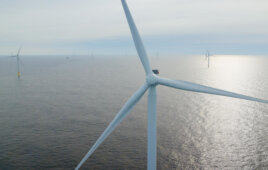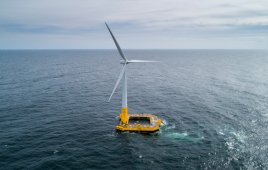An environmentally friendly coating provides a hard yet flexible protection for parts headed to hazardous duty on wind turbines.
Nef Robles, NA Wind Energy Market Manager
Patrick Scalera, Technology Manager, Surface Treatments
Henkel Corporation
www.henkelna.com/windpower
www.henkelec2.com

An assortment of parts with different substrate materials has been coated with Alodine EC² and show an attractive soft gray color.
Wind turbines and their components are exposed to a number of challenging environmental conditions such as corrosion, dust, moisture, ultraviolet radiation, and temperature variations that drive condensation and evaporation of moisture. Like gasoline to a fire, corrosion can act as accelerant, resulting in a component’s catastrophic failure.
To protect from corrosion and other environmental conditions, a multi-functional coating has recently been introduced for use on components found in wind turbines and other applications where long-term reliability is crucial. Intended to replace older surface treatments such as heavy zinc phosphate, organic coatings, and electroplating, the electroceramic coating combines chemical, corrosion, temperature, and abrasion resistance many times greater than traditional coatings.
In addition, the electroceramic coating enhances aesthetics of finished goods, significantly increasing the working life of components. Furthermore, the coating can reduce part and processing costs by allowing its use on lower cost substrate materials.
The electroceramic coating, applied in a “green” coating process, extends the life of parts used on onshore and offshore wind generation sites, delivering ceramic toughness that is flexible and durable. These coatings have become widely used in the marine vehicles, automotive, appliance, and cookware industries where they protect parts constantly exposed to moisture, fuel, oil, salt and other environmental contaminants. The coating is RoHS, WEEE and ELV compliant because no heavy metals are used or deposited on the coated part.
An electroceramic overview
Introduced in 2007 by Henkel Corp. as Alodine EC2, the electroceramic coating works on the surfaces of most light metals such as aluminum, aluminum alloys, titanium, titanium alloys, and aluminized, aluminum-plated and IVD or Ion Vapor Deposition aluminum substrates. The coating is also suitable for aluminized ferrous materials.
Based on a titanium analog of electrodeposited oxides, the electroceramic coating forms a protective layer of titanium oxide ceramic that resists corrosion, increases wear resistance and reduces surface friction of the finished coated surface. The ceramic layer provides a smooth finish, so parts generally have a soft feel similar to that of a finished ground surface.
The coating can provide long-lasting protection for external and internal wind turbine components such as blade tips, ladders, platforms, instrumentation, brackets, and connectors. Naturally flexible and tough, the electroceramic coating provides a protective barrier that resists chips and flakes. As tested with a gravelometer, this new coating provides protection far superior to that of e-coat and paint. The finish appears as a light metallic grey and requires no post-application chemical, thermal, or infrared cure.
This electroceramic coating is compatible with most typical paint finishes such as e-coat, powder, and liquid paint systems, and provides an excellent base for paints, adhesives, sealants, and thermal spray coatings. The material significantly improves the retention of oils, lubricants, and thread lockers.
The electroceramic-coating process is much less complex than traditional surface treatment chemistries. Requiring fewer processing steps, it allows for faster process speeds and reduced processing costs.

Alodine EC2 takes only six steps while conventional coatings can take up to 16.
The technical side
An electrolytic process deposits the specially formulated ceramic layer onto the surface of a metal substrate.
The parts are being coated with the electroceramic material.
The ceramic layer ranges from 3 to15-microns thick of transition metal oxide using the titanium analog as a focus. The coating has a hardness of 637 to 800 Vickers, as tested with a nano-indenter, yet it is extremely flexible. The coating’s roughness is less than 0.07 microns with a coefficient of friction of 0.2 dry, resulting in a smooth finished surface.
When a metal substrate is coated with an electroceramic material, the surface resists abrasion and provides increased wear resistance. (Tested to 10,000 Taber cycles, CS-10 Wheel, with a TWI (Tabor Ware Index) of 1.5) This low wear index outperforms more traditional coatings such as electroless nickel by a minimum of 3 to 1. Unlike traditional finish coatings, electroceramic coating exhibits a pass rating for flexibility of 1-2 T bend, per ASTM D 4145.
The useful coating remains intact. With proper current flow, the electroceramic material will coat the metal substrate in any area wet with the chemistry. This means that internal passageways, crevasses and holes can benefit from the coating technology, not just the exteriors of parts.

Impact Test to Metal Fracture (breaking of metal) shows a failed substrate but the coating stayed intact even through complete metal fracture.

Standard Initial Impact Test (bending of metal) shows that coating retains 100% adhesion through impact test.
Electroceramic coating is stable at high temperatures, to 900°C, well beyond the melting temperature of aluminum. In applications where thermal resistance is critical, electroceramic coating will remain intact even when substrates fail, situations that can be experienced in pumps, compressors, and engines.
Material substitution
The mechanical, chemical, and life cycle requirements of finished parts dictate the substrates selected for use in an assembly. Designers and process professionals go to great lengths to select the appropriate substrates for an end-use environment and the forces it experiences.
A material’s cost and its appropriateness for an application strongly factor into substrate selection. With the electroceramic coating, engineers can consider potentially cost saving alternative substrates for components found in wind turbines such as ladders, clamps, platforms, instrumentation, blade tips, and parts within the nacelle.
By treating substitute materials with electroceramic coatings, less expensive substrates can perform at levels meeting or exceeding the performance of the most expensive materials. In fact, on smaller, non-utility turbines, even aluminum blades and spinners are plausible if treated with electroceramic coatings.
By using less dense materials, designers can potentially reduce the weight of components. Through material substitution, manufacturers can reduce overall materials costs without sacrificing performance or working part life as shown by the coated plates in the impact test..
Other benefits
The electroceramic coating is easily repaired by putting the coated part through the application process an additional time for the electroceramic coating to deposit itself back on the damaged area.
Unlike many traditional coatings, electroceramic coating does not have to be stripped off or sanded down prior to reprocessing. When parts undergo a subsequent application, the new coating builds itself on the area that is bare and evens itself out to a uniform layer with the original deposited coating.
Electroceramic coatings provide a surface that is ready for paint, bonding to, and finish coated. The final surface is thousands of times harder than paint, yet is as flexible as paint.
Parts treated with electroceramic coatings require no additional primers prior to bonding with most adhesives. After applying the electroceramic coating to a substrate, the part can be treated with Teflon, Kynar, and other thermal spray coatings as needed.
In the real world

Award-winning, redesigned Ocean X Stern Drive from Volvo Penta resists corrosion thanks to Alodine EC2 electroceramic coating.
Although not a wind power application, what Volvo Penta engineers experienced with the coating can be useful to turbine OEMs and their suppliers, especially if their equipment is headed offshore.
Volvo Penta, a supplier of engines and complete power systems for marine and industrial use, recently redesigned one of their engine exhaust systems and stern drives used on 20 to 35-ft pleasure craft. The goal of the redesign was to make the equipment more durable in saltwater and reduce weight of the assemblies. Reducing weight means that boats can accelerate more rapidly, plane out faster and travel at higher top-end speeds using less fuel.
Intended for use with select gasoline and diesel engines, the Volvo Penta Ocean X stern drive and engine exhaust are higher quality, more environmentally-friendly components that provide pleasure craft owners with enhanced performance, lower operating expenses, and fewer warranty issues.
Redesigning the stern drive
Continuously exposed to seawater, Volvo Penta’s stern drive and prop assembly housings are made completely of aluminum, a material susceptible to corrosion. To protect the material, the company had been applying a chromate coating to the aluminum for more than 30 years.
Chromate has long been the industry standard to retard corrosion, but it contains an extremely hazardous, EPA-regulated carcinogen that can contribute to medical problems including various cancers and skin irritations. Also, the process for chromate-coating generates hazardous water-waste effluent that requires a complex on-site water treatment facility.
During the redesign, the company had two goals: Better protect the stern drive assembly from corrosion, and eliminate the dangerous, expensive, and environmentally hazardous chromate coating process.
Redesigning the manifold
As of January 2010, the EPA introduced new emissions regulations requiring catalytic converters to improve exhaust emissions. Anticipating this deadline, Volvo Penta engineers began to redesign the exhaust manifold two years earlier to meet the pending federal requirements. But adding a catalytic converter would not only add to the overall size of the engine exhaust system, it would also greatly increase its weight.
The manifold exhaust stream gets as hot as 850ºC. Exhaust gases must pass through aluminum and rubber components before they are expelled into the water. To ensure components do not melt from exposure to super-heated gases, seawater passes over the manifold, cooling the exhaust. Because seawater is highly corrosive, few substrate materials withstand continuous exposure.
The existing exhaust system was made of heavy cast iron and painted for corrosion resistance. To reduce the weight of the newly-designed, larger engine exhaust system, Volvo Penta engineers wanted to use a lighter substrate material, such as aluminum, but were challenged to find a material that could withstand the corrosive seawater and temperature extremes.
Representatives from Volvo Penta encountered Alodine EC2 electroceramic coating technology at a conference. Designed to work on most light metal surfaces, the coating forms a protective layer of titanium-dioxide ceramic that resists corrosion, increases wear resistance and reduces surface friction on the finished coated surface.
Alodine EC2 is an environmentally safe with a less complicated coating process that generates no effluent that would require water treatment processing. This coating technology lets Volvo Penta engineers substitute aluminum as the substrate of choice for the manifold redesign. The lighter coated substrate exceeded their expectations. Because aluminum is much less dense than cast iron, the company reduced the weight of the exhaust manifold, improving both fuel economy and overall performance.
The electroceramic coating is compatible with most paint finishes such as e-coat, powder, and liquid paint systems. Hence, the coating easily accepted the paints used to make the Ocean X stern drive and engine exhaust more aesthetically pleasing.
Aluminum components coated with the electroceramic have now been used at Volvo Penta since 2008. Corrosion resistance is significantly improved when compared to chromate coated parts. In tests, electroceramic coated parts were scratched and then subjected to salt water immersion. With EC2, scratched surfaces easily resist corrosion damage creep, and the deepening and widening of the damaged area.
Filed Under: Offshore wind




